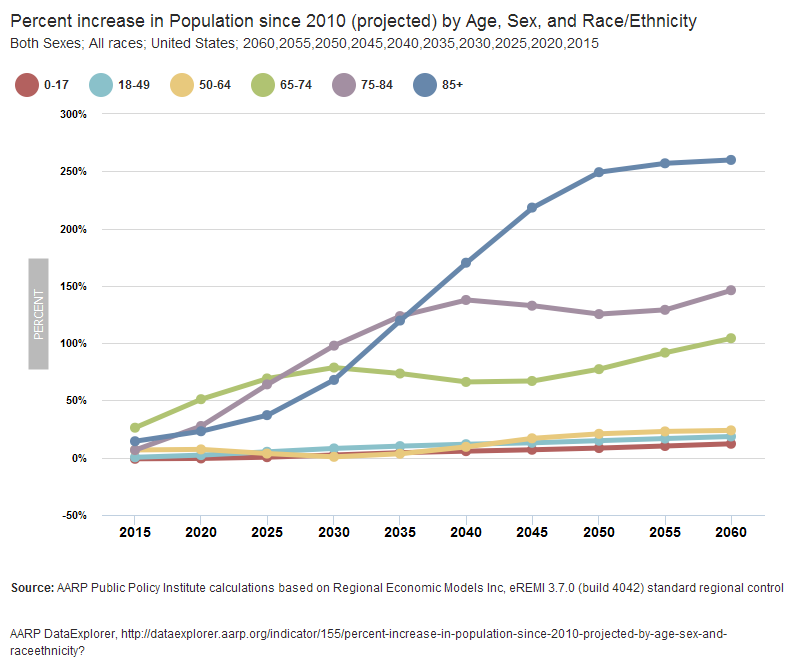AARP Hearing Center
The Skyrocketing of the Age 85+: AARP Data Explorer Provides Long-Term Services and Supports Data for Policy Solutions
By Wendy Fox-Grage, March 11, 2016 08:45 AM

From 2010 to 2060, the age 85-plus population will more than triple (+260%), the fastest growth of any age group over that time period.
This demographic phenomenon will have a significant impact on every aspect of our society, ranging from our health care system to the economy. People age 85-plus are the group most likely to need long-term services and supports to help them with everyday tasks. They not only have higher rates of disability than younger people, but they are also more likely to be living alone, without a spouse or other family member to provide them with assistance.
How does the growth of older populations compare to younger populations? The answers are in the newly released AARP Data Explorer, an interactive website located at http://dataexplorer.aarp.org. This online resource can display the data in the form of graphs, tables and maps.
AARP Data Explorer clearly shows that the age 65-plus population will grow much faster than younger age groups. All three older age groups (65-74, 75-84 and 85-plus) will more than double between 2010 and 2060, while the younger age groups (0-17, 18-49, 50-64) will increase only slightly.
The growth of the age 85-plus population will significantly outpace all other age groups, once the boomers begin turning 85 in the 2030s.
For the next 15 years (2015-2030), the older age groups (ages 65-74, 75-84 and 85-plus) are projected to grow at similar rates. Currently, the age 65-74 cohort is growing fastest, as the boomers are aging into this group. Beginning in 2031, the boomers will begin to turn 85 years old and will cause a spike in the age 85-plus group over the next two decades.
Today, people who are age 85 and older make up only 2 percent of the U.S. population. By 2060, they will represent 4.8 percent, but there are significant variations by state.
From 2010 to 2060, the age 85-plus population is projected to more than quadruple in 14 states: Alaska (up 615 percent), Nevada (565 percent), Colorado (458 percent), Utah (457 percent), Georgia (445 percent), Texas (422 percent), Arizona (416 percent), Virginia (369 percent), North Carolina (324 percent), California (322 percent), New Hampshire (318 percent), Idaho (316 percent), Washington (314 percent) and Maryland (313 percent).
States are undertaking significant changes in the way they deliver and fund services and supports for older adults and their family caregivers. It is imperative that data help drive the policy solutions. Go to AARP Data Explorer for a treasure trove of data on the 50-plus population.
This blog is the first in a series of articles that will focus on data for long-term services and supports.

Wendy Fox-Grage, a senior strategic policy adviser for the AARP Public Policy Institute, works on state long-term services and supports issues.































































